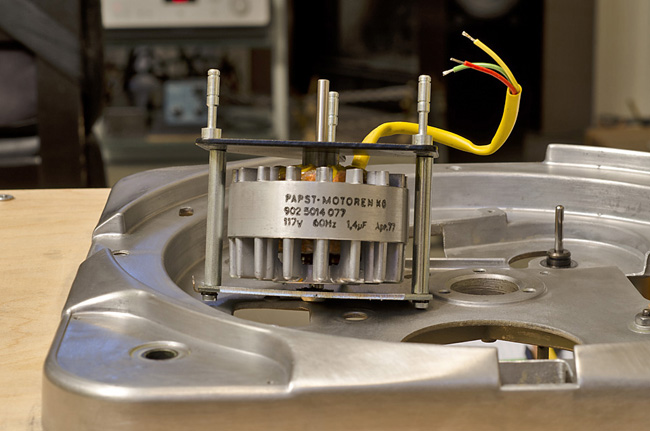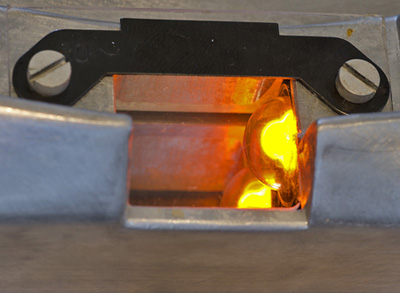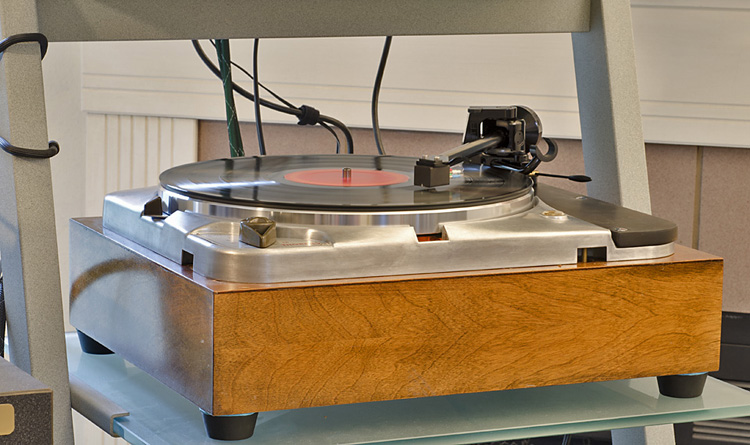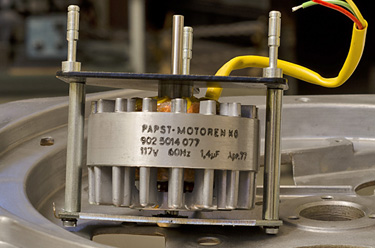-edible zone-
The story goes something like this:
In 1977, ten years after
the TD124 had been discontinued, Thorens management worried that it
could no longer supply new replacement motors for their once
top-of-the-line player. The solution turned out to be the subject of
this article. Thorens contracted with Papst to adapt one of their
"Aussenlaufer" motors to function in the TD124.
Google Translate german to english: Aussenlaufer = outrunner
Sometimes this type of AC three-phase induction motor is referred to as a 'cage rotor' It rotates its round exterior for added torque
*
-- Above photo: A 60 hz version of the Papst Aussenlaufer motor designated by Thorens for use in the TD124. It stands on chassis sn#13943 which has been chemically stripped of its paint in preparation for a complete restoration.
About the Papst:
Thorens Service
Bulletin Nr. 22, October 1977
In German.-- pge two
schematic has english added (roughly)
*
 ( click thumbnail for full size image)
( click thumbnail for full size image)
*![]() fig 3 pencil sketch schematic, in english
fig 3 pencil sketch schematic, in english
__________________horizontal rule
-- Implementation 2/14/2014
(click thumbnail for full size image)
* Bare chassis assembled with the Papst motor. Top View
Bare chassis assembled with the Papst motor. Top View
* Under view with Papst wired per service bulletin Nr. 22 ( I thunk)
Under view with Papst wired per service bulletin Nr. 22 ( I thunk)
* 1.43 uF capacitance. This detail photo shows a combination of capacitors
that add up to 1.43 uF. This value proved to be the quietest running in
this test session. Quietest, but not really "quiet". But there is a
problem with the wire-up. In this photo I have the resistor wire going
to the strobe bulb soldered to the same tag as it would with the E50
installed. But the strobe bulb will not light up this way.
1.43 uF capacitance. This detail photo shows a combination of capacitors
that add up to 1.43 uF. This value proved to be the quietest running in
this test session. Quietest, but not really "quiet". But there is a
problem with the wire-up. In this photo I have the resistor wire going
to the strobe bulb soldered to the same tag as it would with the E50
installed. But the strobe bulb will not light up this way.
* Detail shot of the wire-up at the switch and strobe.
Detail shot of the wire-up at the switch and strobe.
This is the first test session.
Results: Quietest motor
operation was with a cap value of 1.43. This was determined using a
mechanics stethoscope to listen at various points on the td124 chassis
while the motor was in operation. I should note that when probe was
placed in the armboard mount area, motor noise was as audible here as
anywhere else on the chassis.
Strobe: remained dark and showed no
indication of wanting to light up. Bulb looks ok (not burnt) . this part
duplicates my earlier experience while using the service bulletin nr.22
a couple of years back. I'll explore more on this to see if alternate
resistor values may make a difference...or if a different wire-up is
needed.
Strobe fix: 2_16_2014
* It lights up this time.
It lights up this time.
* moved resistor wire to the tag receiving positive voltage. Previously,
the resistor wire was soldered to the tag that is to be used when the
E50 is installed. The strobe works this way with the E50 and not with
the Papst because of a difference in coil windings between the two very
different motors.
moved resistor wire to the tag receiving positive voltage. Previously,
the resistor wire was soldered to the tag that is to be used when the
E50 is installed. The strobe works this way with the E50 and not with
the Papst because of a difference in coil windings between the two very
different motors.
*
sn 13943 fitted with the Papst motor spinning its first disc. Tonearm: Zeta with silver wire. Cartridge: Denon DL-103R with standard conical tip and mounted in a Uwe Ebony body
*![]() Silent Groove plots. (from HFN 001) E50 (td 124 sn 2729) and Papst
(td124 sn 13943) side by side. Note considerable differences.
Silent Groove plots. (from HFN 001) E50 (td 124 sn 2729) and Papst
(td124 sn 13943) side by side. Note considerable differences.
Regardless of what the plots say, early listening to one Paul Simon
record (There Goes Rhymin' Simon) went well with the Papst powered sn
13943. Good energetic thrust. Nice deep bass. High frequencies were not
overtly rolled off. Nice ambience. sparkly atmospherics as they should
be on this record.
More to come. The silent groove plot suggests
there is work to be done.
_________________________________________________________horizontal rule
Operational notes:
As a preface I should make some operational
notes: In this configuration the player is rather slow to get up to
speed. Speed is fast enough to begin play after a few minutes, but it
does take a full record side before it seems to truly lock in at
33-1/3rd. And from that point it holds steady. That's not what it should
be. I can get an E50 motor to perform better in this respect.
There was a service bulletin that came out a couple of years after the
Papst replacement motor was introduced. Bulletin Nr. 23. That message
was that a number of Papst motors had left the factory with the wrong
lube and would be slow to reach speed. The fix was to clean out old lube
and install the correct lube to fix the problem. Perhaps that is what
I'm dealing with here, or maybe it is something else. At any rate I did
put some 20 wt lube into the upper bushing prior to installation. The
lower thrust point has a dab of bearing grease put there by yours truly.
Listening notes: 2_17_2014
I spent a few hours listening
today. Today's list:
- Brahms: Symphony No. 2, HVK/BPH cat DG138 925
- Creedence Clearwater Revival (1st Album) Sundazed Remaster (Stereo)
- Donovan: Sunshine Superman , Sundazed Remaster (mono)
- The Doors: L.A.Woman (Butterfly Label from the original period
- Donovan: Storyteller: MS Music Cat MUS (2) -001 Record 2 at 45 RPM (Steve Hoffman remaster)
- Dave Brubeck Quartet: Time Out (Classic Records remaster)
- Dave Brubeck Quartet: Newport 1958 Columbia CL1249 (mono)
- Brian Auger's Oblivion Express; Straight Ahead RCA APL1-0454
- The Doobie Brothers: Toulouse Street , Warner Bros. BS 2634
- The Beatles: A Hard Day's Night; Parlophone (early seventies re-issue black label single box)
In this configuration sn 13943 is sounding good enough to spend a day
listening to it at length and in depth. Keeping in mind that the
cartridge in use, a DL-103R with standard conical tip, but mounted in a
Uwe Ebony body, has an identifiable sound that has certain limitations
and certain pleasure points. It does not have the most extended upper
frequency. It does have a meaty midrange and a solid, clean (but not at
all lean) lower frequency. Nor is there any overt characteristic about
it. It is hard to go wrong with one of these. And it is less fussy about
record condition as well as some alignment adjustments like VTA/SRA, or
Azimuth, for that matter. At least it is not as fussy as is a line
contact stylus ... like those fitted by SoundSmith on their $250 option.
So I made sure to include some rock titles from the sixties and
seventies among the list of records played. And this was a nice day for
listening.
Transients were (possibly) quicker and (maybe)
sharper in initial attack. (compared to E50 power) Whether that
transient be a violin, an electric guitar or percolating bongos
(Donovan) the beginnings of notes were sudden and palpable in the way
that I'd expect a TD124 reproduce these. Low frequency authority is
increased. As is the visceral force that propels the music. Definitely,
this motor unit has me moving my feet to the rhythms of rock records.
On the Brahms, which I listened to at the beginning of the session,
I did not really notice anything missing. And I did appreciate tones and
textures of massed strings as well as individual players. This is not to
say that I heard everything "clearly" on this record. It is, after all,
a DG pressing. But I was able to appreciate the performance, enjoy the
colors of tone, and take note of the speed at which beginnings of notes
did appear.
On needle drops, and in the blank spaces between
tracks I listened for any trace of audible rumble. And I heard none. Not
even faintly. With the Brubeck records, which get played routinely over
here, I was not missing any musical details. Not that I noticed. Cymbals
seemed to float and shimmer after the initial sharp attack. Desmond's
alto had the full clean airy 'cool' tone I'm used to. Eugene Wright's
double bass was full with a presence that is felt as much as heard. Deep
and with some string slap being apparent. Dave's piano was sounding as
present as I've heard while using this cartridge.
The Creedence
album. This is the first one from 1968, where on side one the first
track is "I Put a Spell on You" originally written and performed by
Screamin' Jay Hawkins. When Creedence does it, this is an energetic and
full bodied performance. I always enjoy it. And I did this time too.
Suzie-Q. Most memorable is the rhythm line that defines the simple
repetitive nature of this tune and it seemed sharply present enough and
with enough force behind it to move ones feet. Did anyone ever listen to
the stupid lyric of it? Toward the end of it there are some Guitar
chords which have an amped-up presence. Like the engineer in the
recording studio turned up the microphone just for these notes. This you
hear no matter what equipment being used, but here, this time, it was
really there. Lots of presence.
Donovan Storyteller. This is a
Steve Hoffman re-master. The first record is of Donovan's early attempt
to become the Scottish Bob Dylan. I did not play from that. I went for
the 2nd record in the set which has 4 tracks recorded at 45 rpm. I
wanted to hear these to find out if there was anything more present
about it. The 4 tracks; Hurdy Gurdy Man, Atlantis, Sunshine Superman,
Mellow Yellow are probably Donovan's best regarded singles. They're
recorded a bit on the hot side on this record. I was not disappointed.
Propelling percolating rhythms. Sudden guitar strikes. Excellent
presence. It might be that this cartridge, with this conical stylus is a
good way to hear it. Yeah. It had me moving my feet whether I wanted to
or not. But I wanted to.
I chose the Brian Auger record to
evaluate this player's ability to bring across the driving rhythm of it.
No disappointment. There is enough released energy coming out of this
record to give the impression of conga drums virtually leaping out of
the speakers sudden-like. It still does that.
To sum, I want to
say that there is an excellent sense of presence and aliveness comng off
sn 13943 with its Papst motor driving it. The motor does have an
external rotor with a finned outer shape. You can hear the rotor beating
the air from underneath. I only notice this when changing records and
even then I have my ear close up and listening just for that noise. It
is faint. Nor does this noise come across from within the electronic
signal. This is just a bit more noise being heard from outside the
player that doesn't really intrude on the listening experience. On this
day it seems like this is a promising path to follow. Let's see if it
isn't possible to get the motor to come up to speed quicker while
operating even smoother. There seems to be promise.
________________________horizontal rule






